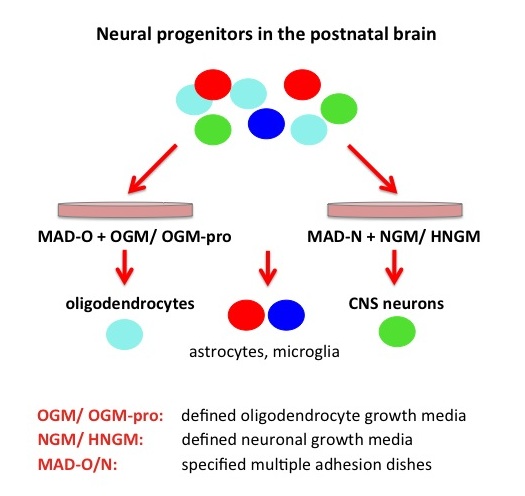MAD-based Technologies
Based on its core competence in neural cell culture technology, neural stem cells and CNS trauma models in a dish, P.Glia is dedicated to the development of unique and easy-to-use techniques for neural cell isolation and culture which allow obtaining defined cell populations (1) in a short period of time, (2) without dedicated equipment, (3) from postnatal mammalian brain tissue and customer´s own transgenic animal model, (4) to be cultured in specialized growth or differentiation media in a progenitor or mature state dependent on their final application. P.Glia approach relies on the presence of neural progenitors/neural stem cells in the early postnatal and adult CNS. With our unique MAD technology, these cells can be obtained and expanded in vitro for various kinds of applications (see chart below). Key elements of this innovative technology are
- the unique MAD (multiple adhesion dish) principle of neural cell isolation based on defined multiple cell binding sites (for different cellular receptors) which allow the isolation of oligodendrocytes or neurons out of mixed brain cell populations on the principle of different adhesive strength
- specialized culture media and reagents for the expansion, survival and differentiation of oligodendroglial, neuronal or neural stem cells in vitro.

The MAD Principle
The MAD (multiple adhesion dish) principle of neural cell isolation relies on basic knowledge in cell biology that the strength of cell adhesion to the surrounding matrix or to other cells strongly depends on the affinity of different cellular receptors to their extracellular ligands and the respective activation of intracellular signaling mechanisms. Ligand-receptor interactions may thus result into diverse adhesive forces varying from very stable to weak or even repellent. The unique properties of MAD-O (for oligodendrocytes) are based on accordingly selected multiple cell binding sites supporting the adhesion of different cell types and of different adhesive strength. Taking an advantage of such molecular mechanisms, the MAD-O surface allows the isolation of NG2 glia/OPCs out of a complex brain cell mixture due to the weak adhesiveness of target cells. Moreover, this takes place under defined culture conditions favoring the growth of the desired cell type (see chart below).
